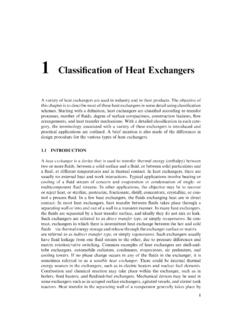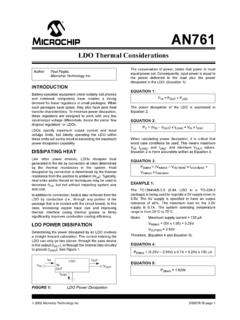Transcription of Heat Transfer in a Rectangular Fin - profjrwhite.com
1 heat Transfer in a Rectangular Fin Fourier's law of heat conduction tells us that the rate of energy Transfer is proportional to the heat Transfer area. Because of this, extended surfaces are used in many applications to help enhance the energy Transfer process. In general, the study of fin heat Transfer is rather complicated because some of the geometries can become quite complex. In these cases, finite difference or finite element modeling is used to discretize the geometry of interest. Energy balances on each nodal volume are performed, which leads to a system of simultaneous algebraic equations.
2 Solving these equations gives a discrete approximation to the temperature profile in the system. This process is actually relatively straightforward and many computer codes have been developed to handle this type of problem. However, the study of finite difference or finite element methods for the solution of boundary value problems (BVPs) is beyond the scope of this course (an introduction to these methods is covered in my Math Methods ( ) course). Fortunately, however, there are a number of practical cases that involve simple 1-D geometries that can be solved analytically.
3 The usual assumption in these problems is that heat conduction along the fin is primarily in one direction, and a simple energy balance on a differential element leads to the defining ODE -- that is, the differential energy balance for the system. The solution of this ODE, along with specific boundary conditions, gives the 1-D temperature profile in the system of interest. Knowing the temperature profile, one can then determine the total energy Transfer , the fin efficiency, and several other quantities of interest. To illustrate this process, consider the sketch of a typical extended surface (obtained from Ref.)
4 1). For steady state, a simple energy balance gives energy flow rate in = energy flow rate out or, using the notation from the diagram, q x = q x +dx + dq conv (1). For 1-D problems, Fourier's law of conduction can be written as dT. q x = kA c (2). dx and Newton's Law of Cooling for convection heat Transfer between a solid surface and a fluid gives dq conv = h dAs (T T ) (3). where Ac = cross sectional area for conduction heat Transfer dAs = surface area of differential element for convection heat Transfer Using a first-order Taylor series representation for qx+dx within the 1-D steady state balance equation, we have Applied Problem Solving with Matlab -- heat Transfer in a Rectangular Fin 2.
5 Dq x qx = qx + dx + dq conv dx or dq x dx + dq conv = 0. dx Now, with the above expressions for qx and dqconv, we have d dT dAs kA c +h ( T T ) = 0. dx dx dx or d dT dAs kA c h ( T T ) = 0 (4). dx dx dx This 2nd order ODE represents the 1-D steady state differential energy balance for an extended surface. In general, it is valid for any 1-D geometry, even ones with variable area ( Ac and As vary with x). Note that the heat Transfer coefficient, h, is assumed to be constant over the surface in the current development. Now, since we want to keep things relatively simple to illustrate the basics, let's assume a simple Rectangular fin arrangement as shown in the sketch (again taken from Ref.)
6 1). Here we see that, in the special case of a Rectangular fin, the following conditions apply A c = constant = wt and dAs = Pdx where P is the perimeter (P = 2w+2t). Now, for the case of constant thermal conductivity, k, eqn. (4) reduces to d 2T hP. (T T ) = 0. dx 2 kA c or d 2T hP. 2. m 2 (T T ) = 0 with m2 = (5). dx kA c where m2 is simply a constant that simplifies writing the ODE. This equation is often studied in some detail in introductory heat Transfer texts since it can give lots of insight into the subject of fin heat Transfer .
7 To obtain a unique solution to eqn. (5), we need to specify two unique boundary conditions (BCs) for the problem. One common situation is for a fixed base temperature, Tb, and a convective tip condition. Mathematically, these specific BCs can be written as Lecture Notes for Applied Problem Solving With Matlab by Dr. John R. White, UMass-Lowell (May 2003). Applied Problem Solving with Matlab -- heat Transfer in a Rectangular Fin 3. dT. T(0) = Tb and k = h (T T ) x = L (6). dx x = L. Equations (5) and (6) define a specific BVP. Since this problem has constant coefficients, its solution is particularly straightforward, as follows: First, we let = T T to give a homogeneous equation, where d dT d 2 d 2T.
8 = T T = =. dx dx dx 2 dx 2. Therefore, eqns. (5) and (6) become d 2 . 2. m 2 = 0 (7). dx with d . (0) = Tb T = b and k = h ( T(L) T ) = h x = L = h L (8). dx x = L. Now, since the ODE has constant coefficients and is homogeneous, we assume a solution of the form (x) = e rx , which leads to the characteristic equation r 2 m2 = 0. with roots r1,2 = m . Thus, the general solution to eqn. (7) becomes (x) = A1e mx + A 2e mx or (x) = C1 sinh mx + C2 cosh mx (9). where the hyperbolic sine and cosine functions are defined as follows: e mx e mx e mx + e mx sinh mx = and cosh mx =.
9 2 2. For problems with a finite length, it is usually more convenient to use the second form. Thus, applying the BCs to eqn. (9) gives BC #1: (0) = C1 (0) + C2 (1) = b or C 2 = b (10). d . BC #2: k = h x = L. dx x = L. k ( C1m cosh mx + C2 m sinh mx ) x = L = h ( C1 sinh mx + C2 cosh mx ) x = L. k ( C1m cosh mL + C2 m sinh mL ) = h ( C1 sinh mL + C2 cosh mL ). Lecture Notes for Applied Problem Solving With Matlab by Dr. John R. White, UMass-Lowell (May 2003). Applied Problem Solving with Matlab -- heat Transfer in a Rectangular Fin 4.
10 And, with the use of eqn. (10), we can solve this for C1, giving h . sinh mL + cosh mL . mk C 1 = b (11). h cosh mL + sinh mL. mk Putting the constants C1 and C2 back into the general solution gives the unique solution, h . sinh mL + cosh mL . (x) mk = cosh mx sinh mx b h cosh mL + sinh mL. mk We can simplify this a bit by putting all terms on the RHS over the same denominator, h h . cosh mL + sinh mL cosh mx sinh mL + cosh mL sinh mx (x) mk mk . =. b h cosh mL + sinh mL. mk Now, from the following identities for the hyperbolic functions, sinh(u v) = sinh u cosh v cosh u sinh v and cosh(u v) = cosh u cosh v sinh u sinh v we have, upon substitution of u = mL and v = mx, our final expression for the desired temperature profile, h (x) cosh m(L x) + mk sinh m(L x).




